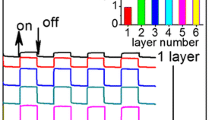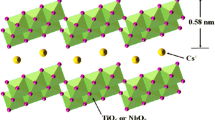Abstract
Cationic porphyrins (i.e., [Ttolyl(P-(C6H5)3)4]4+, where Ttolyl = 5,10,15,20-tetrakis tolylporphyrin and CdTe capped with glutathione) were electrostatically self-assembled via a layer-by-layer methodology onto ITO electrodes and characterized by UV–Vis spectroscopy, cyclic voltammetry, electrochemical impedance spectroscopy (EIS) and SEM-EDX microscopy. Cyclic voltammetry studies of the cationic porphyrin [Ttolyl(P-(C6H5)3)4]4+ demonstrated its ability to absorb both glassy carbon and ITO electrodes. The electrochemical properties of the hybrid porphyrin/quantum dot films (i.e., ITO/{[Ttolyl(P-(C6H5)3)4]4+/CdTe}n, where n = 1–5 is the immersion step) were explored in buffer solutions in the presence or absence of the Fe(CN) 3−6 /Fe(CN) 4−6 redox couple at pH 7.0. The resistance to electron transfer determined by cyclic voltammetry and EIS is in agreement with the increase in the UV–Vis absorption of the material adsorbed onto the ITO surface for each newly assembled bilayer. The prepared bilayers exhibited an interesting homogeneous morphological distribution of CdTe quantum dots on the surface, which indicated the ability of [Ttolyl(P-(C6H5)3)4]4+ to organize CdTe nanoparticles on the ITO surface. EDX analysis of the bilayers confirmed the presence of Cd, Te, and S from the quantum dot. Linear sweep voltammetry indicated that ITO/{[Ttolyl(P-(C6H5)3)4]4+/CdTe}5 has oxygen reduction electrocatalytic properties and demonstrated a synergetic effect between the cationic porphyrin and the CdTe quantum dot.










Similar content being viewed by others
References
Gu J-Y, Chen T, Wang L, Dong W-L, Yan H-J, Wang D, Wan L-J (2014) Electrostatic-interaction-induced molecular deposition of a hybrid bilayer on Au(111): a scanning tunneling microscopy study. Langmuir 30(12):3502–3506. doi:10.1021/la500873y
Shen Y, Zhan F, Lu JF, Zhang BY, Huang DK, Xu XB, Zhang YB, Wang MK (2013) Preparation of hybrid films containing gold nanoparticles and cobalt porphyrin with flexible electrochemical properties. Thin Solid Films 545:327–331. doi:10.1016/j.tsf.2013.08.002
Araghi M, Mirkhani V, Moghadam M, Tangestaninejad S, Mohammdpoor-Baltork I (2012) Synthesis and characterization of a new porphyrin-polyoxometalate hybrid material and investigation of its catalytic activity. Dalton Trans 41(10):3087–3094. doi:10.1039/c2dt11865c
Bazzan G, Smith W, Francesconi LC, Drain CM (2008) Electrostatic self-organization of robust porphyrin-polyoxometalate films. Langmuir 24(7):3244–3249. doi:10.1021/1a7031658
Dong T, Chen FW, Du JB, Hu CW (2010) A multilayer film for bifunctional electrocatalyst and electrochemical sensor based on polyoxometalate and tris(1,10-phenanthroline)ruthenium. J Cluster Sci 21(4):779–787. doi:10.1007/s10876-010-0339-1
García M, Carfumán K, Díaz C, Garrido C, Osorio-Román I, Aguirre MJ, Isaacs M (2012) Multimetallic porphyrins/polyoxotungstate modified electrodes by layer-by-layer method: electrochemical, spectroscopic and morphological characterization. Electrochim Acta 80:390–398. doi:10.1016/j.electacta.2012.07.039
Gomez-Romero P, Chojak M, Cuentas-Gallegos K, Asensio JA, Kulesza PJ, Casan-Pastor N, Lira-Cantu M (2003) Hybrid organic-inorganic nanocomposite materials for application in solid state electrochemical supercapacitors. Electrochem Commun 5(2):149–153. doi:10.1016/s1388-2481(03)00010-9
Han ZG, Zhao YL, Peng J, Liu Q, Wang EB (2005) Inorganic-organic hybrid polyoxometalate containing supramolecular helical chains: preparation, characterization and application in chemically bulk-modified electrode. Electrochim Acta 51(2):218–224. doi:10.1016/j.electacta.2005.04.016
Santo I, Rebelo SLH, Balula MSS, Martins RRL, Pereira M, Simoes MMQ, Neves M, Cavaleiro JAS, Cavaleiro AMV (2005) Association of Keggin-type anions with cationic meso-substituted porphyrins: synthesis, characterization and oxidative catalytic studies. J Mol Catal Chem 231(1–2):35–45. doi:10.1016/j.molcata.2004.12.021
Shen Y, Liu JY, Jiang JG, Liu BF, Dong SJ (2003) Fabrication of a metalloporphyrin—polyoxometalate hybrid film by a layer-by-layer method and its catalysis for hydrogen evolution and dioxygen reduction. J Phys Chem B 107(36):9744–9748. doi:10.1021/jp035274y
Wang B, Vyas RN, Shaik S (2007) Preparation parameter development for layer-by-layer assembly of keggin-type polyoxometalates. Langmuir 23(22):11120–11126. doi:10.1021/la701789n
Iost RM, Crespilho FN (2012) Layer-by-layer self-assembly and electrochemistry: applications in biosensing and bioelectronics. Biosens Bioelectron 31(1):1–10. doi:10.1016/j.bios.2011.10.040
Maruyama J, Baier C, Wolfschmidt H, Bele P, Stimming U (2012) Enhancement of oxygen reduction at Fe tetrapyridyl porphyrin by pyridyl-N coordination to transition metal ions. Electrochim Acta 63:16–21. doi:10.1016/j.electacta.2011.12.017
Zhou Q, Li CM, Li J, Cui XQ, Gervasio D (2007) Template-synthesized cobalt Porphyrin/Polypyrrole nanocomposite and its electrocatalysis for oxygen reduction in neutral medium. J Phys Chem C 111(30):11216–11222. doi:10.1021/jp072390i
Cui LL, Lv GJ, Dou ZY, He XQ (2013) Fabrication of iron phthalocyanine/graphene micro/nanocomposite by solvothermally assisted pi–pi assembling method and its application for oxygen reduction reaction. Electrochim Acta 106:272–278. doi:10.1016/j.electacta.2013.05.077
Tollefson J (2007) Worth its weight in platinum. NATURE 450:1–2
Ishihara A, Tamura M, Matsuzawa K, Mitsushima S, Ota K (2010) Tantalum oxide-based compounds as new non-noble cathodes for polymer electrolyte fuel cell. Electrochim Acta 55(26):7581–7589. doi:10.1016/j.electacta.2009.10.063
Christian JB, Smith SPE, Whittingham MS, Abruna HD (2007) Tungsten based electrocatalyst for fuel cell applications. Electrochem Commun 9(8):2128–2132. doi:10.1016/j.elecom.2007.06.001
Bard AJ (2010) Inner-sphere heterogeneous electrode reactions. Electrocatal J Am Chem Soc 132:7559–7567
Tributsch H, Koslowski UI, Dorbandt I (2008) Experimental and theoretical modeling of Fe-, Co-, Cu-, Mn-based electrocatalysts for oxygen reduction 53:2198–2209
Charreteur F, Jaouen F, Ruggeri S, Dodelet JP (2008) Fe/N/C non-precious catalysts for PEM fuel cells: influence of the structural parameters of pristine commercial carbon blacks on their activity for oxygen reduction 53:2925–2938
Tributsch H (2007) Multi-electron transfer catalysis for energy conversion. Electrochim Acta 52:2302–2316
Anastasopoulos A, Blake J, Hayden BE (2011) Non-noble intertransition binary metal alloy electrocatalyst for hydrogen oxidation and hydrogen evolution. J Phys Chem C 115(39):19226–19230. doi:10.1021/jp205287b
Ahmed MS, Jeong H, You JM, Jeon S (2011) Electrocatalytic reduction of dioxygen at a modified glassy carbon electrode based on Nafion (R)-dispersed single-walled carbon nanotubes and cobalt-porphyrin with palladium nanoparticles in acidic media. Electrochim Acta 56(13):4924–4929. doi:10.1016/j.electacta.2011.02.090
Lisdat F, Schafer D, Kapp A (2013) Quantum dots on electrodes-new tools for bioelectroanalysis. Anal Bioanal Chem 405(11):3739–3752. doi:10.1007/s00216-013-6789-1
Qian HF, Dong CQ, Weng JF, Ren JC (2006) Facile one-pot synthesis of luminescent, water-soluble, and biocompatible glutathione-coated CdTe nanocrystals. Small 2(6):747–751. doi:10.1002/smll.200500530
Zeng X, Bao J, Han M, Tu W, Dai Z (2014) Quantum dots sensitized titanium dioxide decorated reduced graphene oxide for visible light excited photoelectrochemical biosensing at a low potential. Biosens Bioelectron 54:331–338. doi:10.1016/j.bios.2013.10.057
Vaishnavi E, Renganathan R (2014) “Turn-on-off-on” fluorescence switching of quantum dots-cationic porphyrin nanohybrid: a sensor for DNA. Analyst 139(1):225–234. doi:10.1039/c3an01871g
Zhu K, Hu XY, Ge QY, Sun QJ (2014) Fluorescent recognition of deoxyribonucleic acids by a quantum dotimeso-tetrakis(N-methylpyridinium-4-yl)porphyrin complex based on a photo induced electron-transfer mechanism. Anal Chim Acta 812:199–205. doi:10.1016/j.aca.2013.11.007
Jin H, Choi S, Velu R, Kim S, Lee HJ (2012) Preparation of multilayered CdSe quantum dot sensitizers by electrostatic layer-by-layer assembly and a series of post-treatments toward efficient quantum dot-sensitized mesoporous TiO2 solar cells. Langmuir 28(12):5417–5426. doi:10.1021/la202892h
Algar WR, Kim H, Medintz IL, Hildebrandt N (2014) Emerging non-traditional Forster resonance energy transfer configurations with semiconductor quantum dots: investigations and applications. Coord Chem Rev 263:65–85. doi:10.1016/j.ccr.2013.07.015
Shi CN, Anson FC (1990) Catalytic pathways for the electroreduction of O-2 by iron tetrakis(4-N-methylpyridyl)porphyrin or iron tetraphenylporphyrin adsorbed on edge plane pyrolytic-graphite electrodes. Inorg Chem 29(21):4298–4305. doi:10.1021/ic00346a027
Toma SH, Santos JJ, Nikolaou S, Araki K, Toma HE (2012) Direct assembly of a metallodendrimer encompassing seven triruthenium clusters units. Inorg Chim Acta 390:148–153. doi:10.1016/j.ica.2012.04.026
Toma HE, Araki K (2000) Supramolecular assemblies of ruthenium complexes and porphyrins. Coord Chem Rev 196:307–329. doi:10.1016/s0010-8545(99)00041-7
Garcia C, Ferraudi G, Lappin AG, Isaacs M (2012) Synthesis, spectral, electrochemical and flash photolysis studies of Fe(II), Ni(II) tetrapyridylporphyrins coordinated at the periphery with chromium(III) phenanthroline complexes. Inorg Chim Acta 386:73–82. doi:10.1016/j.ica.2012.02.023
Kubat P, Lang K, Prochakova K, Anzenbacher P (2003) Self-aggregates of cationic meso-tetratolylporphyrins in aqueous solutions. Langmuir 19(2):422–428. doi:10.1021/1a026183f
Kubat P, Lang K, Kral V, Anzenbacher P (2002) Preprogramming of porphyrin-nucleic acid assemblies via variation of the alkyl/aryl substituents of phosphonium tetratolylporphyrins. J Phys Chem B 106(26):6784–6792. doi:10.1021/jp014405x
Kubat P, Lang K, Anzenbacher P, Jursikova K, Kral V, Ehrenberg B (2000) Interaction of novel cationic meso-tetraphenylporphyrins in the ground and excited states with DNA and nucleotides. J Chem Soc Perkin Trans 1(6):933–941. doi:10.1039/a909466k
Sheng ZH, Han HY, Hu XF, Chi C (2010) One-step growth of high luminescence CdTe quantum dots with low cytotoxicity in ambient atmospheric conditions. Dalton Trans 39(30):7017–7020. doi:10.1039/c002618b
Van Caemelbecke E, AD, Hambrigth P, Garcia R, Doukkali A, Saoioabi A, Ohkubo K, Fukuzumi S, Kadish KM (2005) Electrochemistry of [(TMpyP)MII]4 + (X = Cl- or BPh4-)…. Inorg Chem 44:3789–3798
Wang HL, Sun Q, Chen M, Miyake J, Qian DJ (2011) Layer-by-layer assembly and characterization of multilayers of a manganese porphyrin linked poly(4-vinylpyridinium) derivative and poly(styrenesulfonic acid-o-maleic) acid. Langmuir 27(16):9880–9889. doi:10.1021/la2022165
Fernandes DM, Ghica ME, Cavaleiro AMV, Brett CMA (2011) Electrochemical impedance study of self-assembled layer-by-layer iron-silicotungstate/poly(ethylenimine) modified electrodes. Electrochim Acta 56(23):7940–7945. doi:10.1016/j.electacta.2011.01.046
Díaz C, García C, Iturriaga-Vásquez P, Aguirre MJ, Muena JP, Contreras R, Ormazábal-Toledo R, Isaacs M (2013) Experimental and theoretical study on the oxidation mechanism of dopamine in n-octyl pyridinium based ionic liquids–carbon paste modified electrodes. Electrochim Acta 111:846–854. doi:10.1016/j.electacta.2013.08.103
Jean-François Koenig DM (2008) Applying UV–Vis spectroscopy to step-by-step molecular self assembly. Thin Solid Films 516:3865–3872
Acknowledgments
Camilo García wishes to thank FONDECYT for 3130328 Postdoctoral Project. F. Fuenzalida wishes to thank CONICYT for 21110540 doctoral scholarship. M. J Aguirre wishes to thank FONDECYT for the 1120071 project.
Author information
Authors and Affiliations
Corresponding author
Electronic supplementary material
Below is the link to the electronic supplementary material.
Rights and permissions
About this article
Cite this article
García, C., Fuenzalida, F., Ruiz, D. et al. Electrochemical, spectroscopic and morphological characterization of electrostatic self-assembled hybrids of tetracationic phosphonium porphyrins and CdTe quantum dots. J Appl Electrochem 44, 1345–1353 (2014). https://doi.org/10.1007/s10800-014-0741-8
Received:
Accepted:
Published:
Issue Date:
DOI: https://doi.org/10.1007/s10800-014-0741-8




